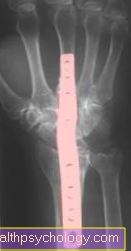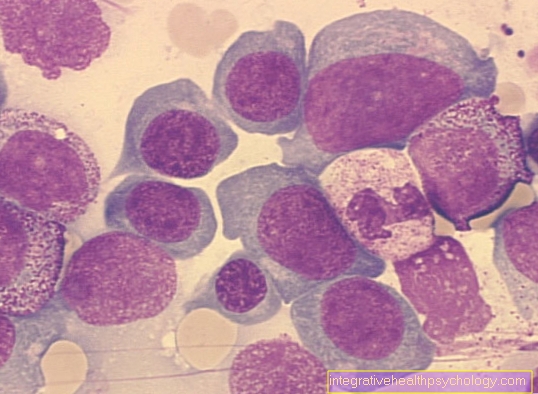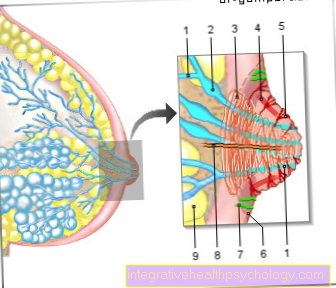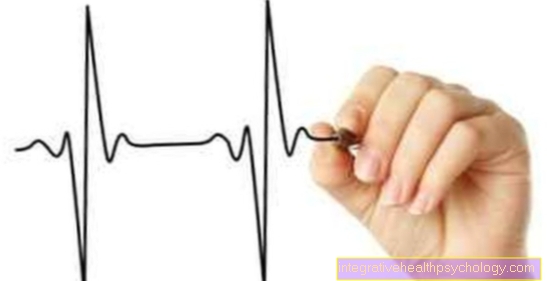urea
definition
Urea is an organic compound that is created in the human body as the end product of the urea cycle and is then excreted primarily through the kidneys, but also through sweat.
Urea contains the substance "ammonia", which is toxic to humans. This accumulates in various metabolic pathways of the amino acids in the body and is then packed in urea and excreted. It is important not to confuse urea with uric acid.

Urea cycle
The urea cycle is a chain of metabolic reactions in the human body, which ensures that the toxic substance "ammonia" is packaged as urea in order to then excrete it in a safe way.
Organic substances are continuously built up, broken down or converted into one another in the human body. The play an important role in this amino acids. They are the basis for proteins and are therefore the most important building material in the body. The other way around, this means that amino acids are formed when proteins are broken down. When amino acids are broken down, a wide variety of substances are produced. Some of them have a carbon skeleton and can therefore provide energy. Another large proportion of degradation products, however, is nitrogen, which, in combination with hydrogen, converts to ammonia (NH3) or ammonium (NH4 +).
Ammonium is the name of the variant of ammonia that occurs in the human body. Ammonia is usually immediately converted to ammonium under the conditions prevailing in the body. So that the ammonium does not accumulate in the body, it has to be excreted constantly. Since the substance is supposed to be excreted via the kidneys and is toxic there, it must first be well packaged. This happens as part of the urea cycle.
The Urea cycle takes place partly in the mitochondria and partly in the cytoplasm of a liver cell and consumes a lot of energy. Ammonium is transferred from one substance to another in a continuous process. The first step is the most important because the ammonium together with "Bicarbonate“And with the consumption of energy it is converted into a substance that is no longer toxic to humans. The further reactions change the substance, but the toxic ammonium is already packaged.
The urea cycle is also related to other important reaction pathways in the human body, such as the Citrate cycle. In the last step, urea is split off. This is then transported to the kidneys via the blood, filtered and added to the urine. Urea shows its second great strength: it helps the kidneys to obtain urine by creating a concentration gradient. It is therefore not only constantly excreted via the kidneys, but also plays a crucial role in the kidneys Function of the kidney.
Urea ointment
Urea ointment respectively Urea ointment is mostly used for very dry skin or neurodermatitis.
Most people have already had contact with “urea” without even realizing it. Numerous hand creams contain this substance. Urea means nothing else than urea.
The second important function of urea plays a role here. It fulfills the same function on the skin as it does in the kidney.
As soon as the substance has been absorbed by the skin, urea is in the tissue. There the urea contributes positively to the so-called "osmotic gradient“At. This means that due to its chemical form it increases the number of osmotically active particles in the tissue. A constant exchange takes place between the capillaries, which contain the blood, and the tissue. The liquid always flows to where a high osmotic pressure has arisen. Since this was previously increased in the tissue, more fluid flows from the blood into the tissue. The moisture is increased and counteracts the dryness of the skin.
Urea in the blood
After the urea has been formed in the liver within the urea cycle, it is transported via the bloodstream to the kidneys and excreted there. Therefore, urea is naturally found in the blood. This value should be between 10 and 55 milligrams per deciliter (mg / dl). Both lower and higher values can indicate an organic defect and should be clarified.
You might also be interested in: Urine degraded
Too high levels of urea in the blood
The cause of excessively high urea levels in the blood can be reduced excretion and increased production. Decreased excretion indicates a kidney disease, such as renal insufficiency, decreased blood flow to the kidney, or a kidney filtration disorder.
There may be an increased production of urea if there is a strong breakdown of proteins, such as in a protein-rich diet, dehydration (vomiting, diarrhea), fever, hunger, burns, injuries or cancer
Read more on the subject at: Urea increased
Too low a level of urea in the blood
One reason for low blood urea levels is one decreased production of urea. Causes for this are a low-protein diet, pregnancy, Liver disease, respectively Hepatic insufficiency, overhydration or overacidification (Acidosis) of the body. In rare cases, there may also be an enzyme defect within the urea cycle.
How can you lower the urea in the blood?
If the urea concentration in the blood is too high, the cause should definitely be clarified. Depending on the cause, there are different possibilities to lower the concentration. The most effective way is that Fight cause.
In the case of kidney disease, it is a chronic increase in concentration, which can only be reduced if the kidney function is improved.
If it is an acute increase or an increase without an identifiable cause, you should take a look at the nutrition be thrown, as protein-rich food can greatly increase the urea concentration. In this case, foods that are particularly rich in protein should be avoided. Sufficient fluids should also be consumed as this improves kidney filtration strength. The additional fluid washes the urea out of the body, so to speak. Another option is an overly alkaline diet, as over-acidification of the body can be another reason for the high concentration.
Urea-creatinine quotient
The urea-creatinine quotient is the quotient of the blood serum urea concentration and the blood serum creatinine concentration and should be in the range between 20 and 35. Creatinine is a breakdown product of the muscles and is also excreted via the kidneys.
Since creatinine is produced very regularly and evenly and is almost exclusively excreted via the kidneys, it is very suitable for determining the kidney filtration function and is an indicator of good kidney function.
Read more about this under: Kidney values
Urea breath test
The urea breath test or 13C breath test is a method for Detection of the bacterial species Helicobacter pylori in the stomach. These bacteria produce the enzyme "urease", which splits urea into carbon dioxide and ammonia. During the test, the patient is given urea, which contains “marked” carbon atoms (C atoms). If the patient is colonized with the bacteria, a “labeled” carbon dioxide gas would be produced. This would be exhaled by the patient and can be measured in a device and its amount determined.





























